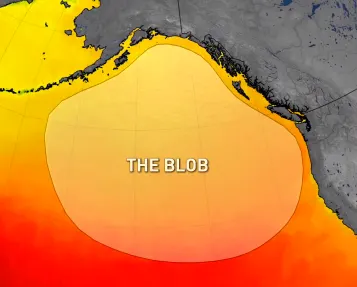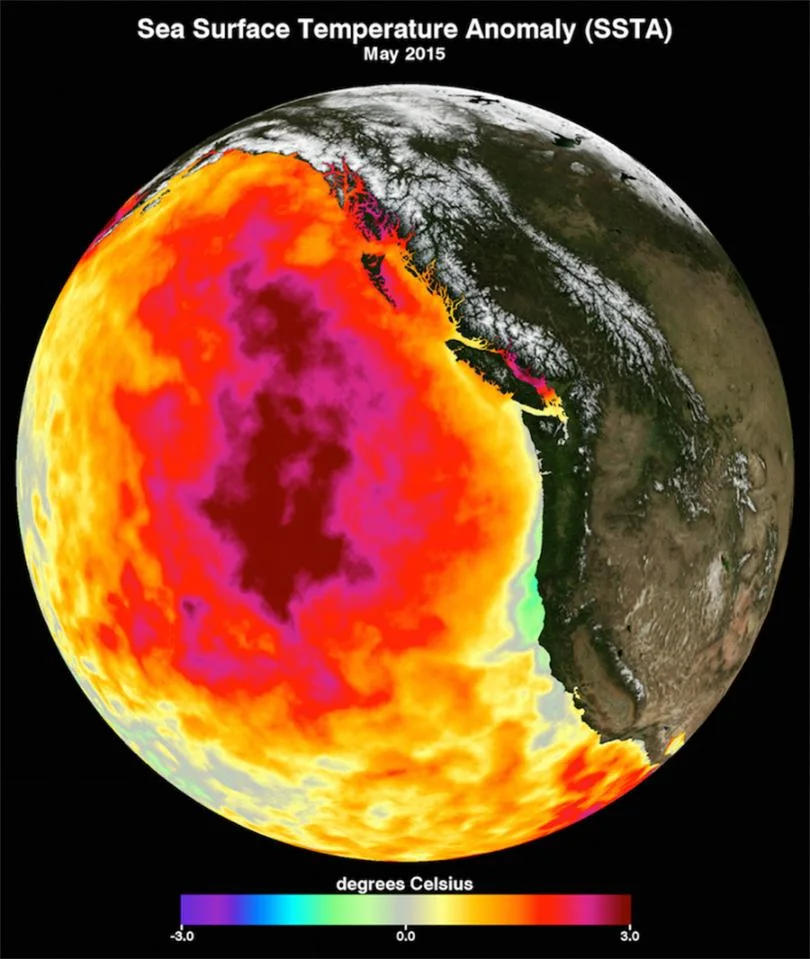
Pacific Blob behind the death of millions of birds
Between 500,000 and 1.2 million birds starved to death during the presence of the Blob between 2014 and 2016.
Scientists appear to have solved the mystery of the death of thousands of birds in the North Pacific region between 2015 and 2016. A new study published in PLOS One attributes the death of 62,000 common murres to “the Blob”, which is an abnormally warm pool of water that began forming in the region during the winter of 2013 and lasted for a couple of years.

The Blob in 2015. Source: NASA
The warmer than usual waters stretched from the North Pacific all the way down to Mexico and affected the region’s marine ecosystems and the related food web. This caused many seabirds, such as the common murres, to lower their reproductive rates and eventually wash ashore with symptoms of malnutrition. The warming temperatures also caused a change in the food supply and a decline in nutrients, which contributed to the plummeting health of the seabirds.

Extreme mortality and reproductive failure of common murres from the northeast Pacific marine heatwave of 2014-2016. Source: Piatt et al.
According to Julia Parrish, a professor of marine sciences at the University of Washington and one of the lead scientists of the study, “a whole new ecosystem was established itself all the way up the food chain.” The type of fish that common murres and other species of auklets normally feed on migrated to colder or deeper waters, making it difficult for them to maintain their nutrition needs.
Related: Why 'The Blob' can be a real terror for marine life
Common murres are usually highly adaptable and are used to travelling faster than other bird species, yet they could not keep up with the changes during this anomalous period of ocean warming. Despite their known ability, lead Scientist John Piatt, a wildlife biologist at the U.S. Geological Survey in Anchorage, Alaska, found that between 500,000 to 1.2 million starved to death during the presence of the Blob between 2014 and 2016. This amounted to a staggering 10 to 20 per cent of their total population.

Hypothesis to explain the dramatic decline of forage fish and starvation of murres across three large marine ecosystems during the 2014–2016 marine heatwave. Source: Piatt et al.
Since murres can easily move to the locations that fish travel to, scientists searched for a more solid explanation to justify the high number of deaths. Beyond the migration of fish prey, there had to be something else beneath the cold Pacific waters that wasn´t favouring their usual food supply.
A look into common North Pacific predator fish like cod, flounder or pollock revealed that a 2°C increase in water temperature increased these species appetites considerably. While thousands of murres were washing ashore with empty stomachs, cod and other fish predators were devouring the murres supply of sardines, capelin and herring. Murres, which weigh close to 2 pounds, need to eat close to 56 per cent of their body mass daily to survive, but Dr. Parish says that “during the warm Blob, they got caught in a competition for absolutely not enough food, which is what killed them.”
The devastating scenario lived by the common murre population and other birds, fish and mammal species during the Blob is a perfect example of how climate change, manifested through ocean temperature anomalies, can cause the collapse of entire ecosystems. Unfortunately, marine heatwaves like the one formed between 2014 and 2016 in the North Pacific, are becoming more frequent and are expected to be the norm in the coming decades.












